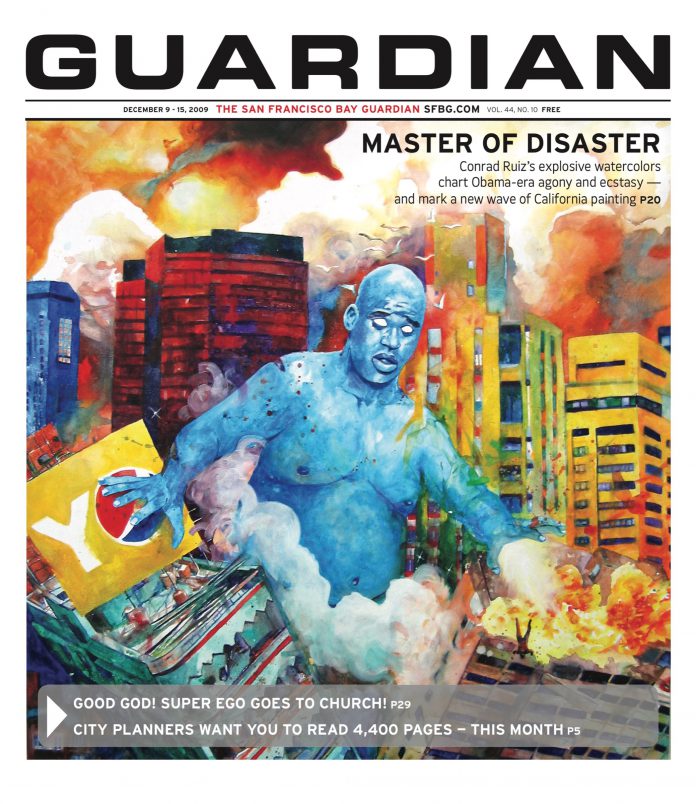news@sfbg.com
Buses seemed more crowded than usual the weekend of Dec. 5-6 as the San Francisco Municipal Transit Agency implemented what it called "the most significant change in more than 30 years," which altered more than half of Muni routes and upset some frequent riders.
The changes were made to save money, although some routes were beefed up in the process. For example, the 26 Valencia was eliminated because of low ridership, but the 14 lines along nearby Mission Street were expanded with longer operating hours and more stops to compensate for discontinued routes. The 9X, 9AX, and 9BX Bayshore Express lines that go through Chinatown have been reorganized and renumbered 8X, 8AX, and 8BX.
"We have a lot of duplicate service either one or two blocks away from another service," SFMTA Executive Director Nathaniel P. Ford said about the reductions and reorganization at a Dec. 2 press conference.
The new route changes are part of a comprehensive plan to deal with dwindling resources and close a $129 million budget deficit. But it will take time for the changes to yield cost savings. "The actual service we are putting on the street — bus-by-bus, dollar-by-dollar — it’s almost a net zero gain in terms of savings," Ford said.
He said the real savings come from the changes made in the bus operator schedule. The projected annual savings from the operator schedule is calculated to be $3.2 million annually. The key element of the route changes is efficiency. "In this particular case, we have been able to enhance the system and maximize our resources overall," Ford said.
But many riders aren’t happy with the changes, and the transit agency still faces an additional $45 million deficit for this fiscal year, partly because it has yet to move forward with plans to extend parking meter hours (see "We want free parking!" Oct. 28) or pursue other revenue generators.
Upset riders
SFMTA says it deployed about 150 agency employees throughout the city as ambassadors to help riders make sense the route changes. No ambassadors were seen over the weekend when the Guardian went out to check out the changes in Chinatown and the Mission District, although notification signs in English, Spanish, and Chinese were posted.
"We do not want customers waiting for buses, for example, that are not coming," said Julie Kirschbaum, project manager of the Transit Effectiveness Project (TEP), the study on which the route changes were based. "And so we are working very hard to interact with customers."
Not hard enough for those in the Chinese-American community, according to a Nov. 19 Streetsblog San Francisco article. Community advocates report the agency didn’t thoroughly inform Chinatown and Visitacion Valley residents about renumbering the Bayshore Express.
When the Guardian asked Ford about this lack of communication, he said that his agency has tried to work closely with the Chinese-American community and other non-English speaking communities. "I think there’s an opportunity for us to continue the dialogue in terms of our communication and outreach," Ford said. He also expects to receive some "positive and not-so positive" comments in the coming weeks.
Some working-class riders are naturally upset over the discontinued routes, particularly the 26 Valencia. Apartment maintenance worker Norm Cunningham said he "wished they hadn’t" discontinued the 26, because it was less crowded than the 14 Mission, which will bear the brunt of diverted passengers. "Now I have no choice but to take the 14," Cunningham told us.
Fast-food worker Damon Johnson said he has already noticed a change in what he called "one of the more reliable" transit systems, including unnecessary delays. "It’s starting to become unreliable," Johnson said. "Now it’s just like the rest of them." Rider Christina Lowery said Muni is still reliable, but she is bummed out by the fare increases, which this year climbed to $2 a ride. Cunningham fears that eventually the price will go up even more. In fact, monthly passes have spiked to $55, and an additional $5 increase is expected next month.
Ford is aware of the financial burden on passengers and said no further increases are currently being considered to solve the budget crisis. Mayor Gavin Newsom also addressed the issue Dec. 3, telling the Guardian: "I don’t want to see an increase in Muni fares."
Ongoing problem
At the moment, Ford said, SFMTA is "100 percent focused" on the route changes, although the budget crisis is always lurking in the background. "We are working with the MTA board as it relates to potential solutions to that $129 million dollar deficit."
As to the stalled proposal to extend parking meter hours that could bring in more revenue, the discussion is ongoing, Ford said. "We have committed to do some meetings with the business communities, and we will bring all of that back to the MTA board at some juncture in terms of making some decisions to close that budget gap."
But future service cuts and additional route changes are possible as a way of dealing with the "physics of our finances," as Ford put it. "Our budget continues to be a challenge but I think this is a great first step in increasing our ridership for the system by providing better service on those corridors that seem to need more capacity, more frequency."
The silver lining for Ford is that this rollout has forced his agency to take a hard look at streamlining Muni. SFMTA officials expect to make further changes and tweaks to Muni over the next six months. For now, you can visit www.sfmta.com or call 311 to see how your commute is affected.

